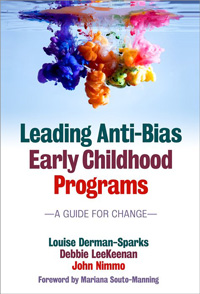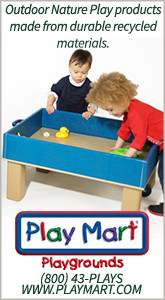ExchangeEveryDay Past Issues
 << Previous Issue
| View Past Issues | | Next Issue >>
<< Previous Issue
| View Past Issues | | Next Issue >> -Maya Angelou
In a Washington Post article prompted by recent racial incidents, "Talking to Small Children about Race," Anne Theriault suggests that parents be forthright in talking to preschool children about race.
Specifically she refutes the concept of Colorblindness — "the idea that you don't see skin color, just people — is quite popular among white folks as a method of handling race and privilege. People who say they just don't see race have found a convenient way of getting out of uncomfortable discussions; claiming colorblindness allows people to not shoulder any responsibility for the role they play in a society that is inherently racist and unequal.
"While I understand that the intent behind proclaiming oneself to be colorblind is a good one, the ideology itself is incredibly problematic, especially when a parent is employing it. For one thing, neglecting to discuss race and privilege with a child — or just leaving it at 'everyone is equal, no matter what' — leaves them incredibly vulnerable to outside messages from society, their peers, and the media they consume.
"For another, touting the inability to see skin color as the best way of interacting with others erases the lived experiences, both negative and positive, of people of color. Parents shouldn't be working to make race invisible or unseeable; instead, they should be celebrating diversity and embracing the idea of multiculturalism."
Leading Anti-Bias Early Childhood Programs: |
|
"You'll find reassurance, resources, and strategic thinking to engage with in this anti-bias work." |

 "For those who are seeking to make a real difference and impact on the world we live in, Leading Anti-Bias Early Childhood Programs lays a road map and foundation for the work ahead."
"For those who are seeking to make a real difference and impact on the world we live in, Leading Anti-Bias Early Childhood Programs lays a road map and foundation for the work ahead."



Comments (9)
Displaying 5 of 9 Comments [ View all ]Mission Viejo, CA, United States
My three-year-old grandson, Rocco, said to my daughter, Magali, when she mentioned that grandma was coming, "Brown grandma." I am a brown-skinned African-American. At first, Magali was a bit taken back by this because they had not discussed race specifically since she is mixed, her father is white, and so is her husband. Magali has lived a mixed-race life although shei is very fair-skinned and most people do not immediately know that her mother is African-American. Her children are fair-skinned but two of Rocco's aunts are brown-skinned like me. Rocco later told his mother that his aunties also have brown skin.
Rocco was not making a racial statement. He was just noticing what is obvious. My skin was darker than his and his parents’ skin and yes, I am his brown grandma. Children see race, ability, and many characteristics that make us unique and to pretend that they do not or should not is setting them up to have inadequate thinking systems to appropriately understand their world. We are alike and we are different but the differences are not an invitation to demean, devalue, or discriminate but an opportunity to show children that they too have unique abilities or differences that they should use to negotiate their world in their own unique fashion.
Noticing how things are alike or different is the beginning of critical thinking and we must embrace these observations by young children and encourage them to express the realities they see. Observation is a foundation skill for scientific thought and problem-solving. Rocco should not be hushed up, chastised, or told, "we don't say those things because it hurts people's feelings." My feelings should not be hurt by an honest observation. I am Rocco’s brown grandma and he is my white grandson. Difference is not deficit. It is what it is.
Mission Viejo, CA, United States
My three-year-old grandson, Rocco, said to my daughter, Magali, when she mentioned that grandma was coming, "Brown grandma." I am a brown-skinned African-American. At first, Magali was a bit taken back by this because they had not discussed race specifically since she is mixed race, her father is white, and so is her husband. Magali has lived a mixed-race life although she is very fair-skinned and most people do not immediately know that her mother is African-American. Her children are fair-skinned but two of Rocco's aunts are brown-skinned like me. Rocco later told his mother that his aunties also have brown skin.
Rocco was not making a racial statement. He was just noticing what is obvious. My skin was darker than his or his parent's skin and yes, I am his brown grandma. Children see race, ability, and many characteristics that make us unique. Pretending that they do not or should not is setting them up to have inadequate thinking systems to appropriately understand their world. We are alike and we are different but the difference is not an invitation to demean, devalue, or discriminate but an opportunity to show children that they too have unique abilities or differences that they should use to negotiate their world in their own unique fashion.
Noticing how things are alike or different is the beginning of critical thinking and we must embrace these observations by young children and encourage them to express the realities they see. Observation is a foundation skill for scientific thought and problem-solving. Rocco should not be hushed up, chastised, or told, "we don't say those things because it hurts people's feelings." My feelings should not be hurt by an honest observation. I am Rocco’s brown grandma and he is my white grandson. Difference is not deficit. It is what it is.
United States
I found a lot of this article quite offensive especially when she says "colorblindness is popular among white folks". Lets talk about the fact that only "white folks" are ever accused as being racist. I am deeply offended by the premise that because I am white I can't be colorblind. I adopted a beautiful African American little girl who I love more than anything in this world and I will tell you right now that when I look at her I DO NOT see color! I see my daughter! Yes we talk about her skin and we talk about my skin and we do it in a POSITIVE way. The same way I taught my other children. We talk about hair and eyes and skin and how everyone is different and everyone is beautiful no matter what. Your article doesn't "address" racism it just pointed a finger at "ALL WHITE FOLK" and articles like this only cause more bad feelings and turmoil. How about you try doing something positive instead of more divisive. Whether you like it or not some people can be "colorblind" especially children! Children don't realize they are different until others point it out! Read the rest of the comments about this article and think about what they say- we all agree with one thing- CHILDREN are colorblind and we don't need adults to promote their opinions and write articles that ARE racist! Just let them be children and teach them to love everyone equally! I am so disappointed that you would even put this article on Exchange Everyday. Your not helping the situation- you're hurting it and hurting the children you supposedly should be looking out for. My daughter is a darker color than I am. I am a darker color than my husband. WE DON'T CARE- WE ARE COLORBLIND! No matter what she is my daughter and I am sick of being accused of being racist just because I AM WHITE!
el paso, texas, United States
When are we going to let children just be children? I agree with many who have said that for the children in our programs color is not an issue and when it comes up we deal with it just like we do other complicated issues - at the child's level. We are not solving the world's problems through our children. We want them to not have to worry about problems we want them to enjoy their childhood. Besides really aren't you all over simplifying - Good Book to read is Trinity. A good example is exactly what you mentioned - whites have privileges - keep pitting us all against each other and we will never raise up and deal with the real issues - always ask yourself what does believing the other person is prejudice against me - do for me? No easy outs in this world we all have a lot to contribute. Lets lift the veil on Autism and tackle that as Americans
United States
I actually think small children are color blind. I have been working with preschool children for over 25 years. When talking about differences in skin color, the children are usually unable to pick out the correct color for their skin (multi-cultural crayons, markers, or paint) or anyone else's for that matter. They love each other without seeing color. Is it something we need to address at that young age? Why not let them discover in their play that they can love anyone, regardless of what they look like? Wouldn't this be a great foundation to build on?
Post a Comment